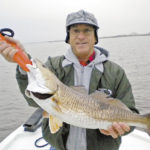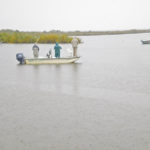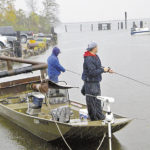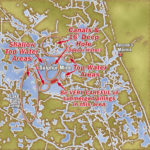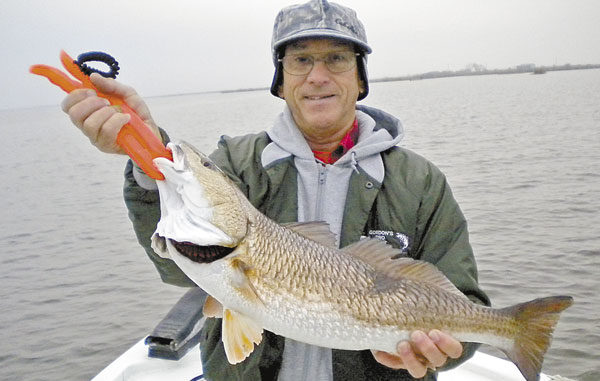
Shun the crowds, and you’ll catch plenty of speckled trout in the Sulfur Mine’s shallows.
February is tough on fishermen. The winds blow hard and cold out of the north, the water falls to some of the lowest levels of the year and what water is left in the marsh is not only low but dirty.
Finding clean water anywhere is a challenge; getting out of the wind is a challenge, and if the cold wind isn’t biting you, the gnats are. And let’s not forget about fog — yet another challenge February anglers are likely to face.
But February isn’t all bad. The old saying is that every cloud has a silver lining, and February does have some redeeming qualities… Such as?
Well, for one, the fish don’t get any closer to the launch sites than they do this month. Everything that swims in the marsh has hunkered down in the deeper interior waters, so nobody should have to run very far to get in on the best action. Less running in the boat means less fuel burned, and less money you’ll have to spend per trip.
What’s more, you won’t need live bait this month. Soft plastics will work just fine, and on moderate days, you can toss topwater baits and suspending baits just like in the spring. Additionally, when you do find the fish this month, they’re often all stacked up in one spot allowing you to do some “one-stop shopping,” and load up the ice chest.
And since you’ll be doing all your fishing in the inside marshes, you can leave the big battlewagons at home and fish out of a smaller, more economical and easier to maneuver boat. It’s actually a great month for kayak fishermen who can take advantage of the nearby hotspots without having to paddle all day just to get into some prime territory. And if you fish out of Basson’s Marina in Galliano, you can even catch some pretty good numbers of fish right off the dock!
We had a trip scheduled to fish with Capt. Gordon Matherne (504-491-3452) on a particular morning, but I thought the forecast calling for cold weather, rain and blustery winds would discourage everybody but Matherne and me from fishing.
“I’m game if you are,” he told me the night before, after we heard the weatherman’s forecast. It’d been so long since I fished I didn’t need much persuasion, so the two of us headed out early the next morning under less-than-ideal conditions.
To my surprise, the boat launch at Galliano was crowded, and we had to wait in line to launch Matherne’s 22-foot Blazer Bay boat. I stepped out of the warm truck into a cold grey mist — the kind that penetrates right through your clothing and clings to any portion of uncovered skin.
I was glad that Matherne chose to launch at Basson’s because it would be a short boat ride to our destination — the Sulfur Mine. Word was definitely out that the Mine was producing fish, because the parking lot was nearly full. Whenever you see that happen on a weekday (unless it’s a holiday), you know the fish are biting.
Basson’s isn’t the only launch site that gives you access to the Sulfur Mine, but it is definitely the shortest ride by boat. The public launch in Golden Meadow and Bayou Blue Launch in Larose are about equal distances from the mine, and may be a bit shorter to drive to (depending on where you’re coming from), but neither is nearly as close by boat as Basson’s.
The marina operates on the honor system, and we put the $5 launch fee in the box just before driving across the levee. I watched a group of kayaker’s huddled over their boats at the dock getting their rigs ready to paddle out into the surrounding marsh, as we waited in line to launch. There were a couple of boats anchored and fishing right off the side of the dock in the deep hole at the marina, but the vast majority of the boats were heading directly to the Sulfur Mine.
On our short ride there, Matherne said on cold days like this one, most of the boats would be anchored over the deep hole in the middle of the mine.
“The hole is about 16 feet deep,” he said, “and trout and reds tend to congregate in that deeper water. I remember when I first started paying attention to the depth when I fished out here, the water was 24 to 25 feet deep back then. And some of the old-timers who fished here before me said it used to be over 50 feet deep in this hole.
“But like everywhere else, the deep holes gradually silt in due to the various storms that stir up the bottom and push sediment all around. It settles in the deep spots, and over time, they silt in and get shallower.”
Matherne said most anglers just anchor somewhere around the deep hole and fish the bottom, and wait for the bite.
“You can’t get antsy if you see the fish biting on the other side of the hole, because the fish seem to move around the circumference of the mine. They’ll come to you. It’s funny to see it happen,” he said, “because you’ll be anchored and you’ll see boats anchored all around the mine. The bite will sometimes start on one side, and then you’ll see it move down the line, as though the fish are on the move and each boat gets a turn to catch some fish.”
But we weren’t heading for the deep hole where the boats were all congregated on this cold morning. We were going to do just the opposite of what you’d expect to do on a frigid day. We were going topwater fishing!
“Every year in January and February, when everybody else is fishing deep, I’ll snap on a topwater bait and start working it over shallow flats and around patches of broken marsh in some prime areas all around the Sulfur Mine,” Matherne said.
By “snapping on” a topwater bait, Matherne meant exactly that. He’s one of the few guides I know who swaps from plastic on a jig to a topwater or shallow-diving hard bait with a snap-swivel. He says there’s a slight difference in the performance of the baits when you use a swivel, but it doesn’t affect their production.
“You won’t catch more fish or less fish because of a swivel, but it does make it much faster and easier to switch from one bait to another, so it’s just common sense to me,” he said. “And the old idea that the swivel will bend or open and cause you to lose a big fish is just extremely unlikely to happen. Not impossible, but not likely.”
Matherne says the shallow edges of the Mine provide for some outstanding topwater fishing action on the east side, the west side, the northeast side and the south side of the deep hole.
“And there is a huge area of shallow ponds on the east side of Bully Camp Lake that is prime topwater territory also,” he said.
He turned the boat into one of the shallow areas away from the congested Mine, dropped the trolling motor and we started casting our MirrOlures just like we’d do in the spring or fall. Only this was the dead of winter, and it was wayyyy too cold for topwater fishing, according to all my reasoning.
“Here we are,” I thought to myself, “bundled up like eskimos, casting topwater baits into cold, shallow water! It just ain’t natural!”
And then a trout slapped at my topwater bait! I was so unprepared for it that I pulled the bait away from the fish in kind of an unthinking reaction. I know that if a fish slaps at your surface bait and misses, you let it sit there a couple seconds, maybe just twitch it a little, to see if you can provoke a second strike. Once Matherne saw that I’d pulled my bait away from the strike zone, he hurriedly grabbed a pole tandem rigged with beetles under a cork, and tossed right where I had the strike.
The cork wasn’t in the water for more than a few seconds when it disappeared under the surface, and Matherne reeled in a nice-sized winter trout.
“I always keep my cork rig ready when I fish a topwater bait,” he said. “Trout and reds will take a swipe at these surface baits and somehow manage not to get hooked, but if you’ll throw beetles under a cork right behind that area where it swiped at you, that fish will usually nail that soft plastic jig. You can toss any soft plastic under a cork, but I like the tandem-rigged beetles best.”
Matherne says the ideal condition for winter fishing these topwater baits is to fish on a day when the air temperature is 50 degrees or above, and on a higher tide.
“The tide can be either rising or falling, as long as it’s moving,” he said. “I actually prefer to fish right when it begins to fall. You’ll want to look for several key things: signs of mullet (or other baitfish) in the water; moving water where a decent current is moving around a point or cut; and shallow water, 1 to 2 feet deep being ideal.”
We trolled shorelines, near cuts and drains, at points and coves, and fished our topwater baits almost exclusively. Matherne is like me in that he’d rather catch a few fish on topwater baits than more fish on the bottom or under a cork. But we managed to catch more than just a few, and some were pretty decent sized — 1½ pounds or so. The shock to me was that the fish would be in such cold, shallow water, and that they’d hit a topwater bait on a day I wouldn’t normally even consider trying it!
“The strange but true fact is, a lot of times these fish will hit a topwater bait when they won’t hit anything else,” Matherne said. “I’ve found that to be true many a time. Especially under conditions like these (cold, gray skies, a light mist in the air, etc.).
“Their usual diet is shrimp, but now that the shrimp are all gone, the trout will prey on small fish like mullet and minnows. The old saying is to match the hatch, or fish with a bait that best resembles what the fish are preying on at that time. And right now, that would be a small fish, something that imitates a minnow, a cocaho or a mullet.”
We also noticed over the course of the morning that you might want to switch the color of your topwater bait if fish start to ignore it. Try a more flashy color or a more subdued color, and see if that doesn’t make a difference. Matherne likes to fish bright colors on cloudy days and more subdued colors on bright days.
“I know that is the opposite of what most anglers advise, but that’s what produces best out here for me,” he said.
We continued to follow Matherne’s method of tossing those beetles under a cork whenever we got “drive-by” swipes at our topwater baits. Several times that morning we’d have a fish swat our MirrOlure, and we’d immediately stop it, let it sit still a couple seconds, then we’d twitch it just a little, and try to mimic a stunned or injured mullet. It they didn’t swat it again with some commitment, we’d slowly resume our walk-the-dog routine.
But on most occasions when we’d have those drive-bys, and we’d throw that cork rig behind the action, they’d nail it.
“That’s a thing to remember,” I told myself, in a likely futile attempt to retain some semblance of a short-term memory.
Matherne spools up with either 14- or 17-pound-test mono, preferring that to braided line, especially for topwater fishing.
“Braid is definitely tougher, but the no-stretch character of the line causes a lot of people to lose fish,” he said. “They pull or jerk too hard and tear the soft mouths of the trout apart. Trout don’t usually swallow a topwater down deep into their throat. They generally get hooked in the mouth, and when that’s the case, you want your line to have some stretch to keep them from ripping it out of their mouths.”
You know what else he said?
“We generally catch more fish early in the morning when topwater fishing in the winter, but believe it or not, I’ve kept a record, and the biggest fish we’ve caught, the 4- and 5-pound beauties, have typically been at about 10 a.m.,” he said.
So there you have it. Sleep late. Fish on days when everybody else stays home or fishes deep. And catch big fish.
February is looking better all the time.
Capt. Gordon Matherne can be reached at (504) 491-3452.
